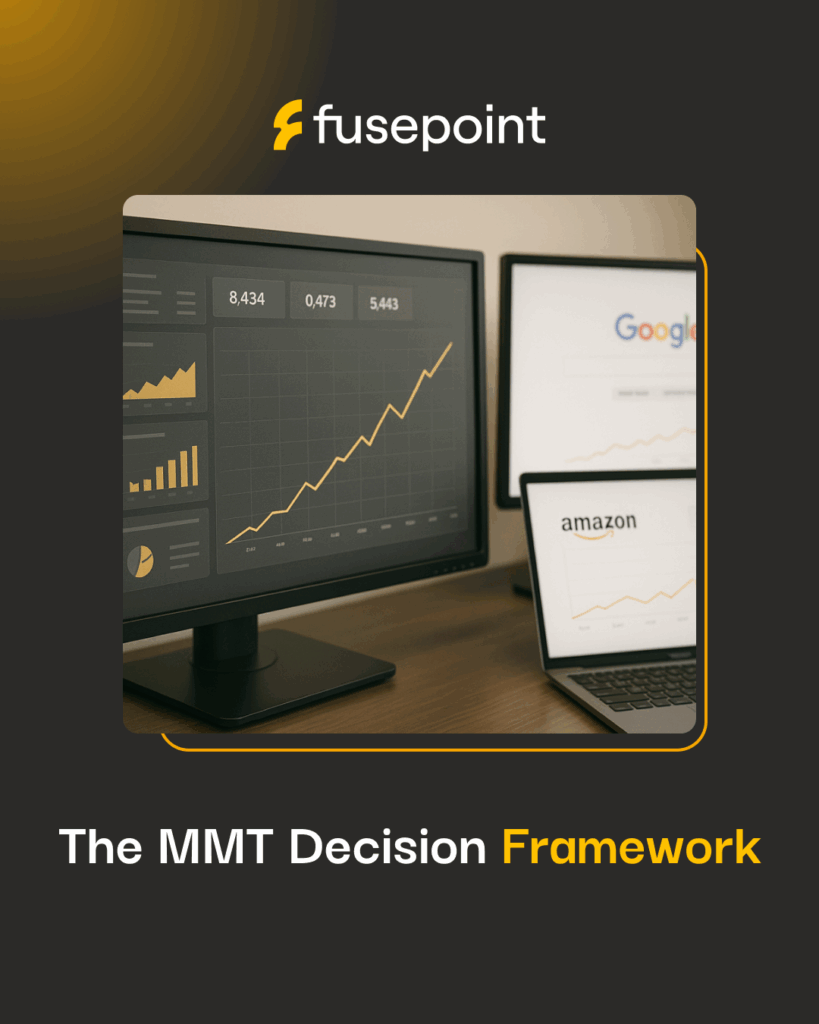Media Planning vs Media Buying: Strategy and Execution in Advertising

- 1. What is media planning?
- 2. What is media buying?
- 3. Examples of different buying methods and when to implement them
- 4. Differences and complementary roles in media buying and media planning
- 5. Media buying vs media planning: Budget governance and diligence
- 6. Mini case callouts: Putting ROI first in Petal & Pup’s planning and buying plan
- 7. Bridge your media team silos with fusepoint
Many marketers discuss media planning and media buying as if they are distinct functions. Planning is treated as a strategy exercise. Buying is treated as pure execution. That divide often creates misalignment, slow learning cycles, and budget decisions that serve the quarter but not the business.
High-performing teams take a different approach. They see planning and buying as two parts of a single system. Planning sets the direction. Buying translates the strategy into real market action, collects feedback from the field, and informs the next plan. When these functions operate together, budgets work harder, insights compound, and performance improves with every campaign cycle.
At fusepoint, we know strategy without execution is theory, and execution without strategy is waste. Ultimately, the feedback loop between planning and buying determines whether ROI is generated or degenerates. With that in mind, let’s examine how media planning and buying work together as two gears in a larger machine.
What is media planning?
Media planning is a strategic blueprint for how advertising dollars are translated into business outcomes. It’s more than deciding which channels to leverage. It’s the discipline of aligning audiences, channels, creative, budgets, and KPIs around profitability targets.
Strong media planning ensures every decision you’ll face downstream is rooted in logic, rather than guesswork. Key pillars of media planning include:
-
Audience segmentation – Ground zero for any media plan is understanding who you want to reach. Customer segmentation breaks down into demographics, psychographics (for B2C), firmographics (for B2B), and human behavior. Effective segmentation emphasizes not just reach potential, but also profitability: which audiences are most likely to deliver lifetime value, not just short-term buy-ins.
-
Channel mapping – Once your priority audiences are clear, the next step is determining where and how to reach them. Channel mapping connects each audience to the media platforms they use the most, cementing channels for each stage of the funnel:
- Awareness
- Consideration
- Conversion
- Retention
These can be broken down further (e.g. Education, Trial/Preference). But the priority is ensuring that each channel is assigned a role, providing you with a comprehensive channel map.
-
Creative direction alignment – Strategy almost always falls flat if creative doesn’t resonate. Chalk it up to Marshall McLuhan’s famed observation that “the medium is the message”: Campaigns that fail to align content and creative with medium and context seldom stick the landing. Robust media plans do more than just place ads—they set the tone, visual assets, and calls to action that make them meaningful to consumers.
-
Budget allocation – Media plans don’t just list channels; they expressly allocate resources across them. Budget decisions should be driven by expected ROI and informed by historical performance benchmarks, blending short-term, revenue-driving plays with longer-term, brand-building choices.
-
KPI schema – Media plans need a clear measurement framework. Before you spend a dollar, it’s critical to define what success looks like. Rather than vague “awareness” goals, effective media planners identify quantifiable KPIs directly tied to ROI, like:
- Cost per acquisition
- Customer acquisition costs
- Incremental return on spend
- Lifetime value
Strong schemas aren’t one and done. They’re built for optimization in perpetuity and reporting that you can always bring back to finance.
What is media buying?
While media planning sets the stage, buying sets the plan in motion. But media buying isn’t solely about execution—at its best, it’s an optimization discipline, constantly tuning and refining to advance a media plan’s KPIs.
Some key actions of media buying include:
-
Negotiation and rate management – Buyers manage the commercial side of placements, securing optimal CPMs, CPCs, and flat rates for ads. Skilled negotiators can also help the business by getting the most out of a media budget, directly bearing on ROI.
-
Safeguards (brand safety, viewability, and fraud) – Unfortunately, fraud is par for the course in modern media buying; invalid traffic is estimated to absorb some 36% of digital ad spend. Ad and marketing fraud has numerous impacts on business, including:
- Throwing metrics out of whack
- Wasting budgets, time, and bandwidth
- Introducing false names and leads to marketing databases
To offset fraud and its consequences, buyers must be adept at using today’s filters and tools for fraud detection. Fluency in viewability standards and brand safety whitelists (“allowlists”) can also offset this form of cybercrime.
-
Real-time optimization – Media planning and media buying should work cooperatively, in a feedback loop. At its best, media buying helps steer future budgets, bids, and placements, using the data they acquire to continuously optimize for future planning cycles.
Examples of different buying methods and when to implement them
Modern media buying outside of standard platforms, such as TikTok, Meta, Pinterest, and Google, encompasses three modes: programmatic, direct, and offline. But these modes can only succeed when teams understand how and when to use them effectively:
-
Programmatic – These are automated bidding platforms like DV320, the Trade Desk, and Amazon DSP that offer audience-first targeting and real-time dashboards for measurement. Efficient, data-driven, and flexible, programmatic buying methods can perform well, but they require significant protection against fraud risks.
Programmatic methods are best for:
- Test-and-learn environments
- Performance-driven campaigns
- Ongoing optimization
-
Direct – Direct methods are negotiated contracts with premium publishers. While considerably less flexible, optimizable, and affordable than programmatic buying, they offer more control, credibility, and clout. Direct methods are best for brand campaigns that hinge on adjacency and prestige, like CPG on lifestyle sites or financial services in well-known publications (think New York Times).
-
Offline – Contrary to popular belief, old-style forms of media like print and broadcast can still be impactful. While they’re not the most efficient methods, offline is exceptional at promoting brand equity and expanding reach when aligned with the appropriate audience segments.
Offline methods are ideal for:
- Cultivating broad awareness
- Geographic plays
- Post-campaign lift studies
The most advanced companies employing this type of buying use a hybrid approach, strategically applied: programmatic for audience appeal and efficiency, direct for impact and control, and offline to cultivate a distinctive cultural presence.
Differences and complementary roles in media buying and media planning
Media planning and media buying are too often discussed as separate functions, with strategy on one hand and execution on the other. But the two promise compounding value when their differences forge a complementary relationship. For example:
-
KPIs and measurement – While planners are often focused on macro outcomes, like CAC efficiency and share of voice, buyers track finer metrics like CPM, CTR, and conversion rates. Ideally, the large and small measurements mesh together to produce durable insights that inform both teams moving forward (and benefit the business as a whole).
-
Skills and responsibilities – Media planners are adept at data analytics, audience research, and financial modeling. Buyers work as seasoned negotiators/optimizers who can offer real-time optimization in often-constrained environments.
It’s common to think of the former as “strategists” and the latter as “operators,” but misalignment ensues when the two aren’t working in lockstep. When they do, media planners cultivate an operational mindset, while buyers lead with strategy, and both teams can win on the business’s behalf.
While media planners and buyers do best when they function as one organism, many campaigns struggle when it’s time to hand off the baton. The fusepoint team finds that fostering regular communication helps support both alignment and cooperation. An effective cadence typically involves regular optimization loop-ins, monthly performance reviews, and quarterly financial or strategy resets between planning and buying teams. At fusepoint, our methodology doesn’t end with measurement, it ends with momentum.
Media buying vs media planning: Budget governance and diligence
Often, media spend is wasted, not due to weak execution, but rather because of poor financial discipline and a lack of understanding in the planning stages.
Both media planning and buying are strengthened when they borrow from diligent fiscal planning, using safeguards to keep spend steered toward business outcomes. Setting concrete, specific targets is one of the best ways to do so. This could look like:
-
Customer acquisition costs, where planning sets the CAC target and buying must deliver against it.
-
Lifetime incremental value, created by marketing spend, rather than the usual LTV. This helps reframe ROI beyond first-customer orders and transactions.
-
ROI thresholds, which can help prevent fixations on per-channel metrics at the expense of total portfolio health (“across all channels, our blended CAC must stay below $X”).
Mini case callouts: Putting ROI first in Petal & Pup’s planning and buying plan
When Petal & Pup reached out to fusepoint, the central challenge was understanding the incremental contribution of each channel in their media mix—particularly Pinterest, whose role in driving revenue was murky.
As usual, we placed experimentation at the core of our overhaul to help reduce risk to investment decisions and offer more clarity around which channels were actually worth scaling. Our approach was methodical:
-
Incrementality testing – In partnership with Petal & Pup, we designed and executed a controlled matched market test to distill Pinterest’s actual revenue impact.
-
Creative experimentation – We launched static, video, and carousel formats to engage the brand’s audience across multiple styles and touchpoints.
-
Performance optimization – We leveraged Pinterest’s Performance+ to maximize catalog sales and conversions.
-
Revenue validation – We confirmed Pinterest’s incremental value by showing that reducing spend directly correlated with revenue declines.
This approach not only proved that Pinterest delivered an iROAS 2x higher than industry standards, but it also showcased the importance of disciplined media planning and buying that prioritizes testing over guesswork.
With this approach, brands can allocate resources with confidence, knowing their chosen platforms can deliver true incremental revenue rather than inflated numbers.
Bridge your media team silos with fusepoint
Digital media buying and planning are two gears in a single system: strategy and execution; finance and operations; theory, practice, and more practice. Brands that align the two enjoy more than short-term efficiency—they get compounding, durable ROI.
RACI (responsible, accountable, consulted, informed) standards can also help ensure all team roles are clear. For example:
-
Planners are responsible for audience logic, budget, and KPI schema
-
Buyers are responsible for execution, optimization, and data safeguards
Both teams are involved in aligning creative, as well as being accountable for shared ROI.
The fusepoint team treats marketing with the same unapologetic rigor as financials, because financials inform every tier of business. To start aligning your planning and buying arms under one comprehensive approach, reach out to a fusepoint expert to learn more about our media planning services.
Sources
Indeed. 6 Psychographics Examples for Proper Marketing Segmentation. https://www.indeed.com/career-advice/career-development/psychographics-examples
Indeed. What Is Firmographic Data? Definition, Benefits and Examples. https://www.indeed.com/career-advice/career-development/firmographic
Harvard Business School Online. Mastering The Buying Journey: Key Stages & Examples. https://online.hbs.edu/blog/post/buying-journey
MIT. Understanding Media: The Extensions of Man. https://web.mit.edu/allanmc/www/mcluhan.mediummessage.pdf
Indeed. CPC vs. CPM Pricing Models: What’s the Difference? https://www.indeed.com/career-advice/career-development/cpc-vs-cpm
Gitnux. Ad Fraud Statistics. https://gitnux.org/ad-fraud-statistics/
HUMAN. What is marketing fraud? https://www.humansecurity.com/learn/topics/what-is-marketing-fraud/
Taylor & Francis. Effects of Offline Versus Online Promotional Media on Consumer Response. https://www.tandfonline.com/doi/full/10.2501/JAR-2024-030
Our Editorial Standards
Reviewed for Accuracy
Every piece is fact-checked for precision.
Up-to-Date Research
We reflect the latest trends and insights.
Credible References
Backed by trusted industry sources.
Actionable & Insight-Driven
Strategic takeaways for real results.








